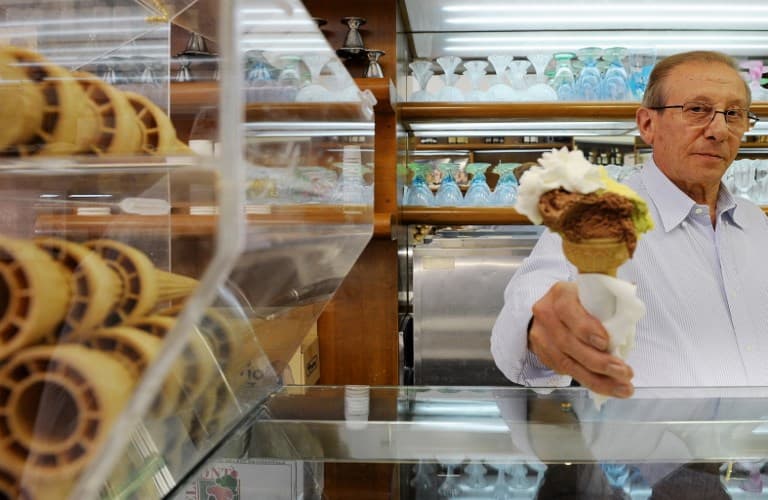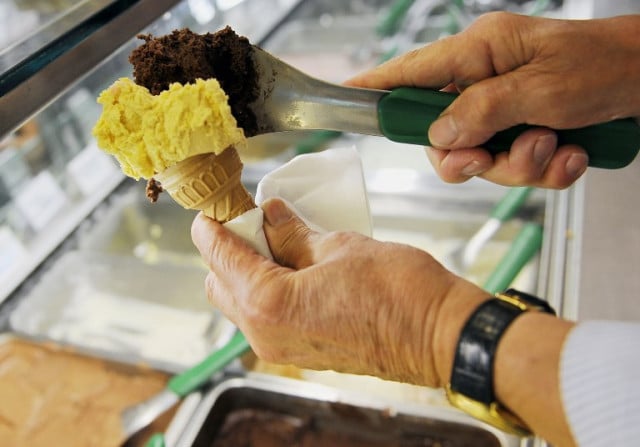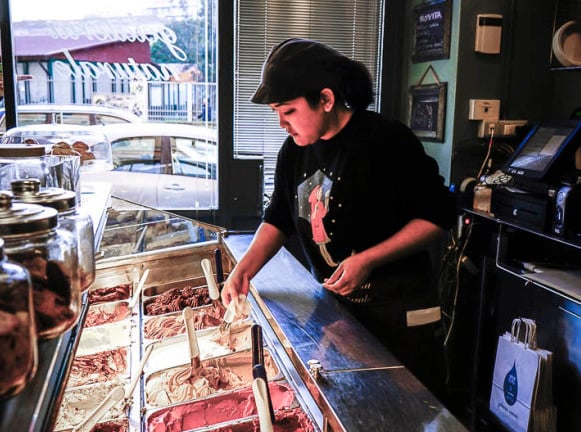'When you eat a cone it is love': Five favorite gelaterie in Rome

American writer John Henderson tasted his first Italian gelato 40 years ago, and he's been eating it ever since. Now a Rome resident, he shares his guide to finding a good gelateria – along with five of his favourites.
I turned 62 last month. But as I licked my way across Rome, I felt the same as I did when I first came to Italy and had my first gelato in front of the Duomo in Milan. I was 22. I’m firmly convinced if I keep eating gelato in Rome I’ll be young forever.
Like everything else in Italy, gelato is all natural, as pure as the olives in olive oil and grapes in wine. It is Italy’s lunch break, its afternoon snack, its nightcap. Strolling the cobblestone passageways snaking off Piazza Navona or in front of the 2nd-century Pantheon, romantic Romans can’t seem to hold their lover’s hand without holding a gelato in their other one.
“When you eat a cone, it is love,” said Nazzareno Giolittli, owner of Giolitti, the hugely popular gelateria near the Pantheon.
“It’s not possible for American people to walk along the street because it’s too frantic. Rome, it’s more slow. It’s a tradition to walk around the city. When old people look at ice cream, they become young again.”
READ ALSO: 'A gelato artist is an emotion-maker'

Photo: Gabriel Bouys/AFP
The key is finding the right gelateria. Gelateria owners — or gelato jockeys as I call them — I talked to and my own mouth-watering wanderings over the years estimate that only about 20 percent of the gelaterias are natural. The rest are industrialized frauds using artificial ingredients and colouring to make the flavours look more inviting.
Want a tip? It’s easy. If the gelato is big and puffy and bright, it probably has more artificial ingredients than a small jet engine. Air creates that puffiness. And if the banana flavour is bright yellow and the pistachio bright green, keep walking. Think about it. Both fruits are kind of grayish.
READ ALSO: How to spot good quality gelato in Italy - and how to suss out the fakes
Real gelaterias present their gelato flattened in tubs. The ingredients are concentrated, real, natural.
Cream flavours consist of egg yolks, milk or cream, sugar plus whatever flavour, be it chocolate or hazelnut or whatever. Fruit flavours consist of water or milk, sugar and fresh fruit.
The real gelaterias change flavours with the season. You won’t find mango in January; you won’t find pear in July. It’s spring and fragole (strawberries) and lamponi (raspberries) are starting to return.

Photo: Alberto Pizzoli/AFP
Here are John's top five gelaterias in Rome, based partly on recommendations and mostly his own taste.
1. Brivido, Via Giovanni Battista Bodoni 62
Living five minutes away, I’ve made Brivido my nightcap. It’s cheaper than another glass of wine and much healthier.
Although purists can argue that getting the free dip into big vats of white and dark chocolate isn’t healthy or traditional, I’m not traditional, either. Biting into a hard, white-chocolate coating and sinking your tongue into soft, creamy flavours of all natural ingredients is my idea of ending the day.
My favorite flavour, amarena (black cherry), is especially good here as they use raw cherries. I loved the new flavour I tried this week, arachide (peanut). Brivido also has a whole line of vegan flavours.
2. Old Bridge, Viale dei Bastioni di Michelangelo
This is extraordinarily biased as I’ve been going here for 17 years. I’ve always liked Old Bridge because of its portions. They’re the largest in Rome but do not sacrifice their natural ingredients.
“Since we opened 30 years ago, we try to use two components: the quality and the quantity of the product,” said owner Gianluciano Mereu. “We always thought that these two things together are fundamental for the success of our work. So we prefer to earn a little less but we give something more to our clients. It’s our philosophy to thank them.”

Photo: Marina Pascucci
Like many gelaterias, Old Bridge goes to great lengths for its natural products. For its most popular flavour, pistachio, Mereu gets pistachios from Sicily near a volcano where the earth is richest. “They’re the best pistachios in the world,” he said.
3. Grezzo, Via Urbana 130
Grezzo opened four years ago in an inconspicuous shop in Monti, arguably Rome’s hippest, liveliest neighborhood today. Matteo Mercolini took a job here slingin’ gelato a few weeks ago.
“After I taste this my conception of gelato totally changed,” he told me. “I can not go to any other ice cream shops.”
Mine changed here, too. Grezzo is famous for its raw chocolate, and its display case is filled with tantalizing little chocolate chunks filled with everything from pralines to various nuts. Gelato has become Grezzo’s side venture, along with its cakes and cookies.

Photo: John Henderson
But the raw chocolate gelato was the best chocolate ice cream I’ve ever had. The chocolate beans are sun-dried, not toasted like most places. So concentrated, the chocolate exploded in my mouth. I paired it with nocciola (hazelnut) which is 40 percent nuts compared to the usual 20 percent, Mercolini said.
“Keeping the process under 42 degrees, it allows us to maintain all the nutritional values and, of course, the flavour is more powerful,” he explained. “It’s more concentrated in the mouth.”
I look forward to this summer when they break out their mango, raspberry, blueberry and passion fruit, which match the chocolate in popularity.
4. Neve di Latte, Via Luigi Poletti 6
Sitting on a side street behind the MAXXI modern art museum in northern Rome, Neve di Latte looks anything but touristy. Its bland grey and white interior makes it look older than its eight years and there’s nothing fancy about the flavours.
But the gelato I had — pistachio and variegato (cocoa, hazelnut, cream) — was spectacular. You could actually taste the cream separate from the cocoa and hazelnut.
How serious do gelaterias take their ingredients? Neve di Latte gets its milk and cream from a biodynamic producer in Germany where the cows graze at about 4,600 feet. Its Amadei chocolate and Parisi eggs are from Tuscany.
Underneath it all, the pistachio was as good as any I’ve ever had and I’ve tried it all over Italy.

Photo: Marina Pascucci
5. Fatamorgana, Via Roma Libera 11 and other locations
This one makes the list purely by its adventurous nature. Fatamorgana, although part of a chain that’s always a red flag, has the most interesting flavours in Rome.
On my visit I saw carrot cake, baklava, Lapsang Souchong, chocolate, blackberry and grapes. I’ve read about such flavours here as cinnamon-apple-nut, tiramisu and blueberry cheesecake. One called Bacio del Principe (Kiss of the Prince) is made of gianduja (a chocolate paste made from ground hazelnuts). Panacea is almond milk, ginseng and mint.
I had its famous banana cream with sesame brittle and the sesame’s salt adds an intoxicating flair to the sweet banana. I combined that with seadas: pecorino cheese from Sardinia, chestnuts, honey and orange peel. You could taste every ingredient, kind of like a fine wine.
The mastermind behind all this is Maria Agnese, a country girl who made gelato as a child but never followed a recipe. She once used leaves from a local orchard’s almond tree and invented almond flowers gelato cream.
READ ALSO: How to make the perfect gelato

Photo: Andreas Solaro/AFP
John Henderson is a writer and expat living in Rome. This is an edited version of an article that was originally published on his blog, Dog-Eared Passport. Find more of his stories here.
Want to write a guest blog for The Local Italy? Get in touch at [email protected].
Comments
See Also
I turned 62 last month. But as I licked my way across Rome, I felt the same as I did when I first came to Italy and had my first gelato in front of the Duomo in Milan. I was 22. I’m firmly convinced if I keep eating gelato in Rome I’ll be young forever.
Like everything else in Italy, gelato is all natural, as pure as the olives in olive oil and grapes in wine. It is Italy’s lunch break, its afternoon snack, its nightcap. Strolling the cobblestone passageways snaking off Piazza Navona or in front of the 2nd-century Pantheon, romantic Romans can’t seem to hold their lover’s hand without holding a gelato in their other one.
“When you eat a cone, it is love,” said Nazzareno Giolittli, owner of Giolitti, the hugely popular gelateria near the Pantheon.
“It’s not possible for American people to walk along the street because it’s too frantic. Rome, it’s more slow. It’s a tradition to walk around the city. When old people look at ice cream, they become young again.”
READ ALSO: 'A gelato artist is an emotion-maker'

Photo: Gabriel Bouys/AFP
The key is finding the right gelateria. Gelateria owners — or gelato jockeys as I call them — I talked to and my own mouth-watering wanderings over the years estimate that only about 20 percent of the gelaterias are natural. The rest are industrialized frauds using artificial ingredients and colouring to make the flavours look more inviting.
Want a tip? It’s easy. If the gelato is big and puffy and bright, it probably has more artificial ingredients than a small jet engine. Air creates that puffiness. And if the banana flavour is bright yellow and the pistachio bright green, keep walking. Think about it. Both fruits are kind of grayish.
READ ALSO: How to spot good quality gelato in Italy - and how to suss out the fakes
Real gelaterias present their gelato flattened in tubs. The ingredients are concentrated, real, natural.
Cream flavours consist of egg yolks, milk or cream, sugar plus whatever flavour, be it chocolate or hazelnut or whatever. Fruit flavours consist of water or milk, sugar and fresh fruit.
The real gelaterias change flavours with the season. You won’t find mango in January; you won’t find pear in July. It’s spring and fragole (strawberries) and lamponi (raspberries) are starting to return.

Photo: Alberto Pizzoli/AFP
Here are John's top five gelaterias in Rome, based partly on recommendations and mostly his own taste.
1. Brivido, Via Giovanni Battista Bodoni 62
Living five minutes away, I’ve made Brivido my nightcap. It’s cheaper than another glass of wine and much healthier.
Although purists can argue that getting the free dip into big vats of white and dark chocolate isn’t healthy or traditional, I’m not traditional, either. Biting into a hard, white-chocolate coating and sinking your tongue into soft, creamy flavours of all natural ingredients is my idea of ending the day.
My favorite flavour, amarena (black cherry), is especially good here as they use raw cherries. I loved the new flavour I tried this week, arachide (peanut). Brivido also has a whole line of vegan flavours.
2. Old Bridge, Viale dei Bastioni di Michelangelo
This is extraordinarily biased as I’ve been going here for 17 years. I’ve always liked Old Bridge because of its portions. They’re the largest in Rome but do not sacrifice their natural ingredients.
“Since we opened 30 years ago, we try to use two components: the quality and the quantity of the product,” said owner Gianluciano Mereu. “We always thought that these two things together are fundamental for the success of our work. So we prefer to earn a little less but we give something more to our clients. It’s our philosophy to thank them.”

Photo: Marina Pascucci
Like many gelaterias, Old Bridge goes to great lengths for its natural products. For its most popular flavour, pistachio, Mereu gets pistachios from Sicily near a volcano where the earth is richest. “They’re the best pistachios in the world,” he said.
3. Grezzo, Via Urbana 130
Grezzo opened four years ago in an inconspicuous shop in Monti, arguably Rome’s hippest, liveliest neighborhood today. Matteo Mercolini took a job here slingin’ gelato a few weeks ago.
“After I taste this my conception of gelato totally changed,” he told me. “I can not go to any other ice cream shops.”
Mine changed here, too. Grezzo is famous for its raw chocolate, and its display case is filled with tantalizing little chocolate chunks filled with everything from pralines to various nuts. Gelato has become Grezzo’s side venture, along with its cakes and cookies.

Photo: John Henderson
But the raw chocolate gelato was the best chocolate ice cream I’ve ever had. The chocolate beans are sun-dried, not toasted like most places. So concentrated, the chocolate exploded in my mouth. I paired it with nocciola (hazelnut) which is 40 percent nuts compared to the usual 20 percent, Mercolini said.
“Keeping the process under 42 degrees, it allows us to maintain all the nutritional values and, of course, the flavour is more powerful,” he explained. “It’s more concentrated in the mouth.”
I look forward to this summer when they break out their mango, raspberry, blueberry and passion fruit, which match the chocolate in popularity.
4. Neve di Latte, Via Luigi Poletti 6
Sitting on a side street behind the MAXXI modern art museum in northern Rome, Neve di Latte looks anything but touristy. Its bland grey and white interior makes it look older than its eight years and there’s nothing fancy about the flavours.
But the gelato I had — pistachio and variegato (cocoa, hazelnut, cream) — was spectacular. You could actually taste the cream separate from the cocoa and hazelnut.
How serious do gelaterias take their ingredients? Neve di Latte gets its milk and cream from a biodynamic producer in Germany where the cows graze at about 4,600 feet. Its Amadei chocolate and Parisi eggs are from Tuscany.
Underneath it all, the pistachio was as good as any I’ve ever had and I’ve tried it all over Italy.

Photo: Marina Pascucci
5. Fatamorgana, Via Roma Libera 11 and other locations
This one makes the list purely by its adventurous nature. Fatamorgana, although part of a chain that’s always a red flag, has the most interesting flavours in Rome.
On my visit I saw carrot cake, baklava, Lapsang Souchong, chocolate, blackberry and grapes. I’ve read about such flavours here as cinnamon-apple-nut, tiramisu and blueberry cheesecake. One called Bacio del Principe (Kiss of the Prince) is made of gianduja (a chocolate paste made from ground hazelnuts). Panacea is almond milk, ginseng and mint.
I had its famous banana cream with sesame brittle and the sesame’s salt adds an intoxicating flair to the sweet banana. I combined that with seadas: pecorino cheese from Sardinia, chestnuts, honey and orange peel. You could taste every ingredient, kind of like a fine wine.
The mastermind behind all this is Maria Agnese, a country girl who made gelato as a child but never followed a recipe. She once used leaves from a local orchard’s almond tree and invented almond flowers gelato cream.
READ ALSO: How to make the perfect gelato

Photo: Andreas Solaro/AFP
John Henderson is a writer and expat living in Rome. This is an edited version of an article that was originally published on his blog, Dog-Eared Passport. Find more of his stories here.
Want to write a guest blog for The Local Italy? Get in touch at [email protected].
Join the conversation in our comments section below. Share your own views and experience and if you have a question or suggestion for our journalists then email us at [email protected].
Please keep comments civil, constructive and on topic – and make sure to read our terms of use before getting involved.
Please log in here to leave a comment.